Do you have a question about the Goodman *MSS9* and is the answer not in the manual?
Details on suspending the furnace from rafters or joists using specific hardware.
Procedure to relocate the pressure switch tube for specific horizontal installations.
Minimum clearance and slope requirements for drain trap and lines.
Ensuring proper condensate drainage through leveling and tilt.
Provisions for electrical and gas line connections through side panels.
Requirement for a drain pan when furnace is above a conditioned area.
Reference to drain trap and lines section for freeze protection.
Requirements for propane gas and high altitude conversions.
Specifies PVC and ABS pipe requirements, primer, and solvent cement.
Explains furnace can be installed as single or dual pipe appliance.
Instructions for safe piping and guidelines for vent/flue terminations.
Details for single/dual pipe installations and connection requirements.
Procedure for using alternate vent/flue locations and combustion air provisions.
Details on drain trap installation and drain hose hookups.
Instructions for draining the furnace and air conditioning coil.
Specific drain connection procedures for upflow furnace installations.
Specific drain connection procedures for counterflow furnace installations.
Information on wiring harness and guidelines for 115V power supply.
Procedure for relocating junction box and wiring for 24V thermostats.
Requirement for a single-stage thermostat for heating control.
Adjustments for high altitudes and instructions for propane gas conversion.
Information about the 24V gas valve and its operation.
Guidelines for connecting and verifying gas piping installations.
Specifics for propane gas tanks, piping, and pressure requirements.
Proper duct design and procedure to measure external static pressure.
Method for return air openings and importance of filter installation.
Possible filter arrangements and locations for upright and horizontal installations.
Filter installation requirements for horizontal furnace installations.
Ensuring proper drainage and initial furnace operation checks.
Step-by-step guides for initiating and safely turning off the furnace.
Procedures for measuring and adjusting gas supply and manifold pressures.
Measuring gas input rate and ensuring correct temperature rise.
Determining cooling tonnage and airflow requirements for blower speed selection.
Steps for selecting, adjusting speeds, and setting heat off delays.
Describes the operational sequences for different furnace modes.
Visual checks of burners and overview of the integrated control module.
Overview of safety circuits monitored by the integrated control module.
Initial troubleshooting steps for basic furnace operational faults.
Diagnosing problems with pressure switches and induced draft blowers.
Troubleshooting limit switches, rollout limits, and flame sensor signals.
Addressing power polarity errors and continuous blower operation.
Details on suspending the furnace from rafters or joists using specific hardware.
Procedure to relocate the pressure switch tube for specific horizontal installations.
Minimum clearance and slope requirements for drain trap and lines.
Ensuring proper condensate drainage through leveling and tilt.
Provisions for electrical and gas line connections through side panels.
Requirement for a drain pan when furnace is above a conditioned area.
Reference to drain trap and lines section for freeze protection.
Requirements for propane gas and high altitude conversions.
Specifies PVC and ABS pipe requirements, primer, and solvent cement.
Explains furnace can be installed as single or dual pipe appliance.
Instructions for safe piping and guidelines for vent/flue terminations.
Details for single/dual pipe installations and connection requirements.
Procedure for using alternate vent/flue locations and combustion air provisions.
Details on drain trap installation and drain hose hookups.
Instructions for draining the furnace and air conditioning coil.
Specific drain connection procedures for upflow furnace installations.
Specific drain connection procedures for counterflow furnace installations.
Information on wiring harness and guidelines for 115V power supply.
Procedure for relocating junction box and wiring for 24V thermostats.
Requirement for a single-stage thermostat for heating control.
Adjustments for high altitudes and instructions for propane gas conversion.
Information about the 24V gas valve and its operation.
Guidelines for connecting and verifying gas piping installations.
Specifics for propane gas tanks, piping, and pressure requirements.
Proper duct design and procedure to measure external static pressure.
Method for return air openings and importance of filter installation.
Possible filter arrangements and locations for upright and horizontal installations.
Filter installation requirements for horizontal furnace installations.
Ensuring proper drainage and initial furnace operation checks.
Step-by-step guides for initiating and safely turning off the furnace.
Procedures for measuring and adjusting gas supply and manifold pressures.
Measuring gas input rate and ensuring correct temperature rise.
Determining cooling tonnage and airflow requirements for blower speed selection.
Steps for selecting, adjusting speeds, and setting heat off delays.
Describes the operational sequences for different furnace modes.
Visual checks of burners and overview of the integrated control module.
Overview of safety circuits monitored by the integrated control module.
Initial troubleshooting steps for basic furnace operational faults.
Diagnosing problems with pressure switches and induced draft blowers.
Troubleshooting limit switches, rollout limits, and flame sensor signals.
Addressing power polarity errors and continuous blower operation.
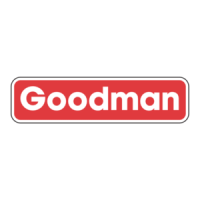


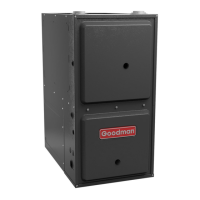
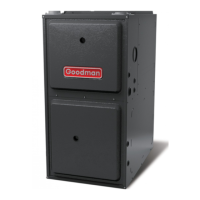
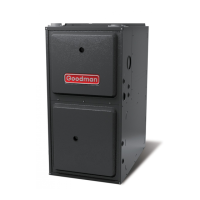
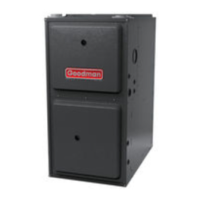

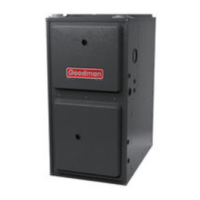


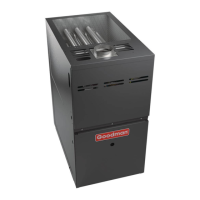
